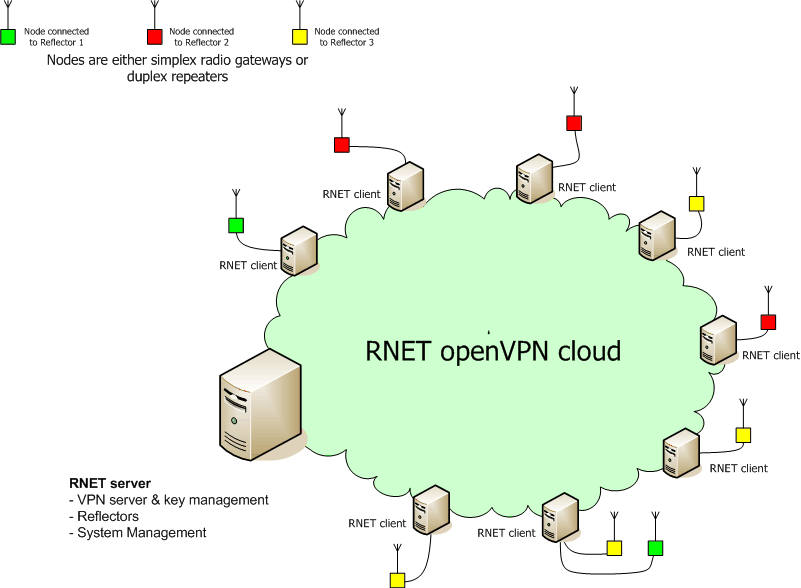R.NET network principle
R.NET network is a OpenVPN based network infrastructure that deploy the Internet as its transit network. VPN technology is used to solve IP addressing issues, allows easy centralized network administration and moderation and minimizes the need to configure firewall and/or NAT rules. Encryption is not used with the OpenVPN solution making it possible to create wireless links to the node locations also over microwave amateur radio bands (mainly 2.3 GHz and 5.6 GHz)
R.NET offers talkgroup services to interconnect repeaters, which means that all nodes connected to a talkgroup can hear each other. At the moment there is one country-wide talkgroup *RNET_Primary* and one talkgroup for testing (*RNET_Test*).
Network topology is a star. Every node is directly connected to the R.NET server (OpenVPN server) that offers the talkgroup services.

R.NET platform provides also solution for multi-RX repeater systems, split-site repeater systems etc. Documentation will follow shortly.
R.NET controller software features:
- Multiple (unlimited) simplex/duplex radio ports for connecting repeaters and simplex radios
- Full repeater controller functions with port linking and unlimited audio routing
- Software 1750 Hz detection Yess!
- Software CTCSS detection and generation
- Software DTMF detection and generation
- Beeps, boops and melodies for courtesy tones and messages
- Speech synthesis support for speech messages
- Pre-recorded messages supported (wav-files etc.)
- Versatile scripting support for all kind of events
- Unlimited commanding possibility with DTMF commands (links, connections, messages, etc)
- Native echolink client as a own virtual port which can be hooked to any other radio ports
- RATS R.NET network client as a own virtual port which can be hooked to any other radio ports
What you can do with R.NET:
- Multi-port repeater controller with a single PC-computer running some linux variant (R.NET installation media will be Debian)
- Multi-site repeater with RX at one node and related TX on other node (each node requires a R.NET client)>
- Multi-RX repeater with several RX nodes and one TX node (each node requires a R.NET client)
- Echolink connectivity (Not interlinked with R.Net linking)
- Linked repeater system with VoIP linking over the internet (That’s R.NET about!)
